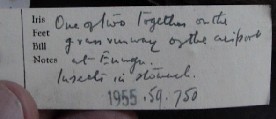


Images copyright (c) Natural History Museum, London

Dr. William Serle made a great contribution to ornithological knowledge, and that of West Africa in particular. Born in Duddingston Manse, Edinburgh on 29 July 1912 he attended George Watson's Boys College before studying medicine at Edinburgh University. His interest in birds followed that of his father who he accompanied on early ornithological trips.
From his father's literature, Dr. Serle realised the great potential for further ornithological research in West Africa. Following his graduation in 1936 he joined the Colonial Medical Service and sailed for Lagos, Nigeria, in 1937.
For the next 20 years, Serle made extensive collections in Nigeria, Sierra Leone, British Cameroon and parts of East Africa. He made 60 publications on status, distribution, breeding and taxonomy. He is credited with the descriptions of 18 new avian taxa, including the rare Mount Kupe Bush Shrike (Malaconotus kupeensios).
During the war he served with the West African Field Ambulance Corps, travelling to India and Burma. He was awarded the O.B.E. in 1946 for his outstanding army service.
Following his marriage in 1956 he felt called to train for the ministry and was ordained and inducted to Drumoak, near Banchory in Kincardineshire, Scotland in 1959, where he remained until his retirement in 1987.
Later he donated the bulk of his skins collections to the Natural History Museum in Tring and his egg collection to the National Museums of Scotland.
Reference
Obituary - Dr William Serle O.B.E, by R.Y McGowan, Department of Natural History, Royal Museum of Scotland, Scottish Birds (1993) vol. 17, pp. 66-67
Personal note
It was only when I obtained a copy of Collin's "A Field Guide to the Birds of West Africa" (1977), prior to our trip to Nigeria, that I realised that the author was one and the same as the Church of Scotland minister and naturalist of Drumoak just east of the town of Banchory where I grew up. My father knew him and I might even have seen him myself! So it was quite fascinating to go through the Plain-backed Pipits trays at the Natural History Museum in Tring seeing so many of his careful hand-written labels on the specimens, as illustrated above for a female Plain-backed Pipit collected on 6 August 1954 at Enugu! What a wonderful legacy...
